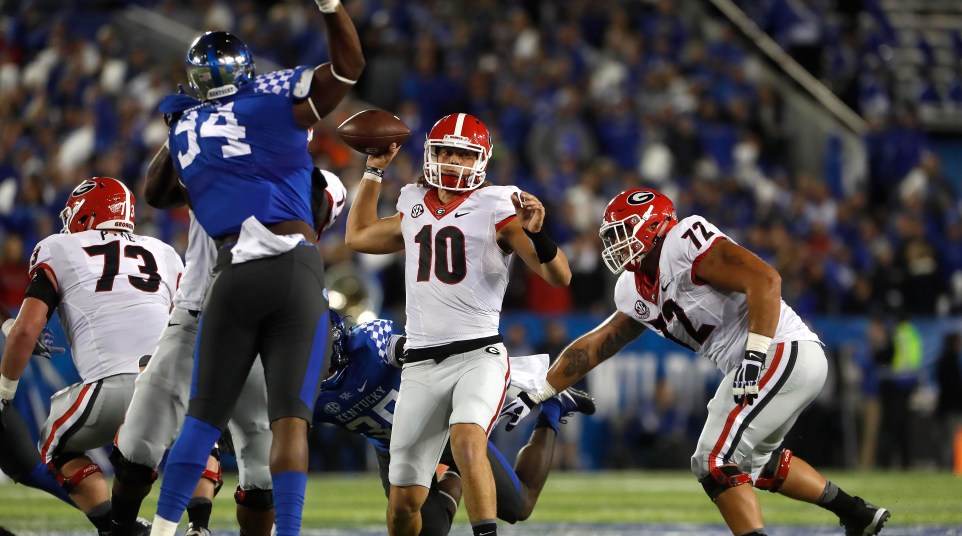
How Jim Chaney’s move upstairs had a positive impact on Georgia’s offense
These past several weeks have been interesting for Georgia offensive coordinator Jim Chaney.
On an imperative fourth down against Vanderbilt, the Bulldogs opted to pitch the ball to 5-foot-8, 175-pound receiver Isaiah McKenzie, who was stopped short of the first-down marker. That decision led many to question why Georgia didn’t hand it to star running back Nick Chubb.
After the Bulldogs’ loss to rival Florida, many asked that same question once again. In one of Georgia’s biggest games, its best player carried the ball only nine times for a meager 20 yards. As a whole, the Bulldogs gained just 21 yards on the ground.
This led Chubb and fellow running back Sony Michel to have an amiable meeting with offensive coordinator Jim Chaney about how the team could get the running game back on track. Chaney also had another meeting after the Florida game that appears to have helped solve Chubb and Michel’s quandary, and aid the offense.
“We came in the Sunday morning after Florida, and we both sat down and talked for a long time and we both agreed it was the best decision,” Kirby Smart said after Saturday’s win at Kentucky about his conversation with Chaney on calling plays from the coaches’ box.
Against the Wildcats, Chaney moved upstairs for the first time and the Bulldogs’ offense responded with a much more balanced effort.
Georgia ran for 215 yards, 127 from Michel and 85 from Chubb, while quarterback Jacob Eason threw for another 245. The Bulldogs showed the most balance on offense since their heartbreaking loss against Tennessee.

Mark Zerof-USA TODAY Sports
Some coaches prefer to be on the field where they can speak directly to players and get in-game feedback on the opponent. On the sidelines, however, a coach’s ability to read the defense often depends on the communication between him and the quarterback. With a true freshman behind center, that communication might not always be as sharp as it needs to be.
In the coaches’ box, Chaney can see the entire field for himself. He can dissect what the defense is doing from a much better angle and determine which areas to attack. What he loses in direct communication, he gains in greater visibility of on-field action.
“For me it’s, ‘He’s sitting up there watching tape,’” Smart told reporters Saturday. “You know, because that’s where you sit and watch tape all week. You’re able to see the same picture. Sometimes, when you’re down on the field, you don’t see that same picture. You rely on the information you get rather than looking at it yourself.”
Georgia ran the ball to much greater effect against Kentucky. The Bulldogs began with three straight plays for Chubb, who gained 27 yards – more than he had in the entirety of his afternoon in Jacksonville.
Much to the frustration of those watching against Florida, the offense appeared to run the ball exclusively between the tackles. In Saturday’s win, Georgia mixed in some outside runs and stretch plays to keep the defense from charging into the A and B gaps.
Of course, it helps if the offensive line can generate the kind of movement it did against Kentucky. It wasn’t a completely overpowering effort, but there was massive improvement up front.
By running the football effectively, Georgia became much more lethal with its play-action passing game, something that plays to Eason’s ability to throw the ball deep.
A balanced offensive plan also helped the Bulldogs on their game-winning drive. By showing Kentucky multiple, successful looks, the Wildcats’ defense was on its heels late in the fourth quarter.
Because Chaney had a full view of the field, he could direct the offense down the field in a more efficient manner.
It became clear early on Georgia’s final drive how it was attacking the defense. Eason threw two consecutive curl routes along the right sideline to Javon Wims, who quickly got out of bounds. Each throw was designed to be delivered as soon as Eason finished his drop and gave him a sense of comfort and rhythm.
His final pass on that drive attacked the left side of the field, where he found Terry Godwin on another quick-hitting play that gained 16 yards after the catch. That play moved Georgia into field goal position and allowed it to run the ball to set up Rodrigo Blankenship’s 25-yard game-winning field goal.
On the Bulldogs’ final drive, and for much of the game, there seemed to be a purpose for each play called. That wasn’t the case against Florida.
Georgia’s offense is at its best when there is a strong blend of run and pass to generate balance. Once Chaney moved to the coaches’ box, that balance finally revealed itself.
Before Saturday’s victory at Kentucky, there was much talk about Chubb and Michel meeting with Chaney. After the win, it’s clear that Smart’s conversation with Chaney made a much greater impact.
William McFadden covers the University of Georgia for Saturday Down South. For news on everything happening between the hedges, follow him on Twitter @willmcfadden.
